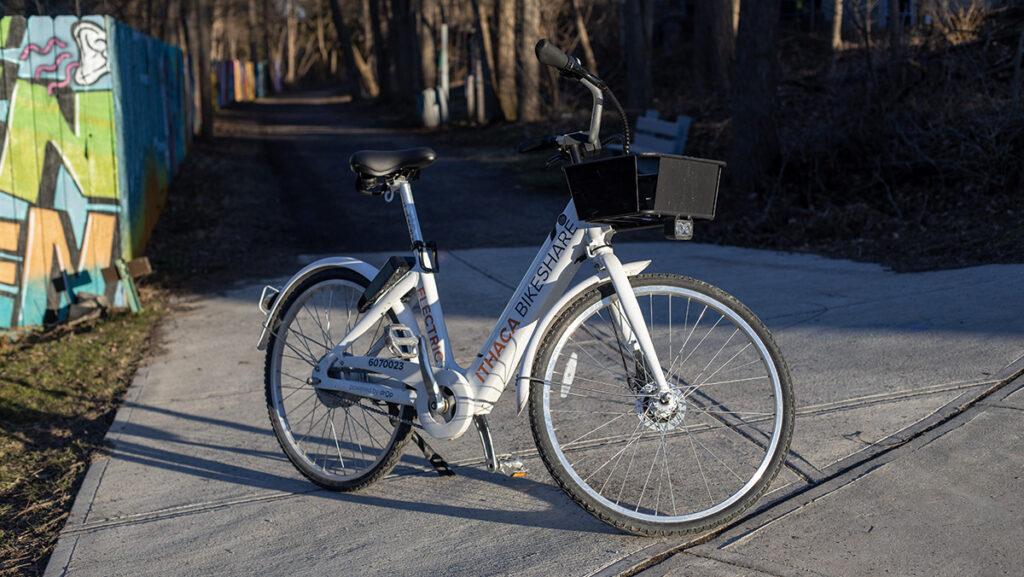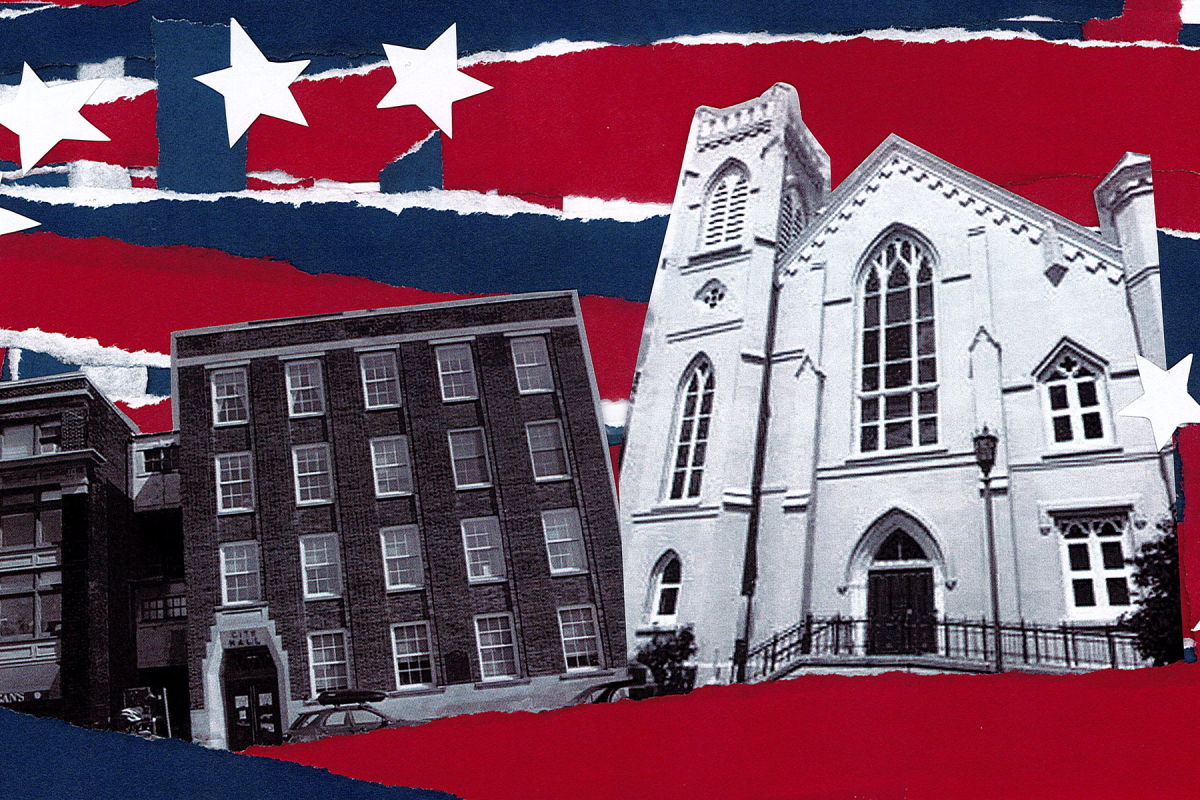Since its launch Nov. 9, 2022, Ithaca Bikeshare has provided nearly 13,179 rides on public bikes. Now, the local organization plans to add more parking hubs and raise the costs of bike use.
Ithaca Bikeshare is a non-profit organization that works to get residents of the City of Ithaca to travel more by bike than by car. The organization created these rides using half as many bikes as the bike-share service Lime, a bike, moped and scooter-sharing company that ended service to several of its cities and was used in Ithaca between 2018 to 2020.
Jeff Goodmark, director of micromobility for the City of Ithaca, said via email that public bike sharing is necessary in Ithaca in order to get cars off the road. Goodmark works with the city to manage how more transportation can happen through biking and walking rather than cars. Goodmark is working with the city to help organize the new initiative after Lime discontinued services in Ithaca.
“The overall reliance on cars is causing many major issues such as pollution, reliance on fossil fuels, and wasted city space for parking,” Goodmark said via email. “All of this ties in with Ithaca’s Green New Deal goals.”
He said the new organization is better for residents because it is locally based, whereas Lime bikes were based in San Francisco.
“Having Ithaca’s name on the bikes, instead of some California company or some startup, makes us hope people feel like they have more of a sense of ownership of the bikes,” Goodmark said.
He said that if residents feel a sense of responsibility toward the bikes, since the program is local, rather than Lime, which was a nationwide company, then residents will make an extra effort to treat the new bikes better and park them in bike hubs located around the city.
The hubs’ locations are visible on the Ithaca Bikeshare app and serve as a safe way to organize parked bikes where they are accessible to other riders. Hubs are not marked physically and are spaced about one to two blocks away from each other.
Goodmark said the interface of the new Ithaca Bikeshare app is similar to that of Lime’s but will now offer more hubs than Lime did. Although Goodmark said he does not know the number of parking hubs Lime had, it was similar to those of Ithaca Bikeshare. Goodmark said he hopes to increase the number of hubs around the city by the end of the year, which will add to the 79 hubs the organization has currently.
Goodmark said the necessity of parking hubs is so people can locate bikes faster and so bikes can be found by using the app.
“The idea of parking hubs is to give people the flexibility to ride wherever they want but also provide some form of predictability in terms of where people can find bikes,” Goodmark said.
Other changes include getting rid of the $1 credit to riders for parking in a hub. Instead of a $1 credit, riders will be charged a $1 fee if they do not park in a hub.
Previously, unlocking a bike cost $1 and $0.15 per minute to ride. Goodmark said that pricing will increase to $0.20 per minute and unlocking a bike will now cost $1.50. Day passes will stay the same price at $20 per day, as will monthly and yearly passes, which are $45 and $150, respectively.
Goodmark said the reason for the changes was that only 10% of Ithaca Bikeshare riders complied with the parking hubs. He said other cities, like New Orleans, that charge $1 for not parking in a hub experienced a 50–60% increase in riders properly using hubs.
Goodmark said a team goes out daily to charge, retrieve and park the bikes. He said it is important for them to look nice so as to make the service seem more appealing.
“It’s the appearance of it being well managed versus not being well managed,” Goodmark said. “Our goal is to try to make [the bikes] look as good as we possibly can.
Goodmark said the Ithaca Bikeshare bikes can make traveling through the City of Ithaca easy and efficient while also helping to improve the city’s sustainability goals by decreasing the number of cars on Ithaca’s roads. Goodmark said Ithaca Bikeshare does not yet have the funds to increase its fleet, which is not known at the time because of bikes going missing or damaged.
“The way Ithaca is laid out for many places downtown, it’s less than two miles, which is ideal for a bike ride, especially for an electric bike ride which goes a lot faster and requires less effort,” Goodmark said.
Fernando de Aragón, director of the Ithaca-Tompkins County Transportation Council, said the council, which is a regional agency that is mandated by the federal government, aims to get less people traveling by car.
“Our primary goals and objectives are to get people to drive less, particularly to drive alone less,” de Aragón said. “To reach that goal, we promote alternatives to driving alone like transit, ride-sharing and then things like car sharing and bike sharing, [as well as] walking and biking in general.”
There are no parking hubs on Cornell University or Ithaca College’s campuses yet, but Goodmark said he hopes that Ithaca Bikeshare will soon be approved by each college and begin digitally marking parking hubs on both college campuses.
“When we look at our data maps of where bikes are flowing and where bike trips start and end, there truly is a massive amount of trips on Cornell campus in particular, Ithaca College as well,” Goodmark said.
Michael Smith, professor in the Department of History, said some college administrators see having the public bikes on campus as a safety issue and how they could put students and the college at risk.
“The campus interior is not really well designed for a lot of bicycle traffic,” Smith said. “There’re walkways, not cycling paths. There would have to be some understanding that students would use them to tear around the main quad. Beyond that, it’s hard for me to imagine why the college wouldn’t want to encourage especially reducing automobile traffic within the campus.”
Some of the college’s students do not want hubs on campus. First-year student Lennon Zych said via email that Ithaca Bikeshare bikes should not be allowed on Ithaca’s campus because of the campus’s terrain.
“Since it’s a significant hike from the bottom of campus to the top, I would not recommend bikes,” Zych said. “I do not believe the sidewalks are wide enough to safely accommodate bikes as well as students.”
However, other students feel that bikes on campus would make traveling across campus much easier and quicker. First-year student Jacob Healt said via email that since people ride their bikes, skateboards and electric skateboards already through campus, the public bikes should be allowed on campus as well.
“I think this could mean greater ease of transportation from one place to another,” Healt said. “For example, if you lived in Circle Apartments, Garden Apartments or even Emerson Hall, you’re quite far away from most of the main campus. Having access to bikes that you could ride to class would be so much better for the environment and easier for the students.”
Smith said he hopes that if the bikes were approved for on-campus use, it would decrease foot traffic and make traveling across campus easier.
“If they could reduce the amount of inter-campus traffic, I think [the bikes] would be really perfect for that,” Smith said. “They would be best for just going from the residence hall to the core of campus here where the classrooms are. Then in addition to what I said before, I think they’re very practical for popping down the hill too, and getting back up with the assist that the electric provides.”
De Aragón said an important factor to get more people onto bikes is to let residents know the bikes are safe for use. He said the Ithaca Bikeshare bikes are a much better product than Lime’s bikes. De Aragón said Lime bikes have a history of not being as supportive as the new Ithaca Bikeshare bikes and were known to rattle.
“We had bikes [from Lime] that were just not working well,” De Aragón said. “Safety has many components. One of them is the vehicle itself, but the others have to deal with [the user]. [It depends on] if you’re a safe rider and it also depends on the infrastructure [like if] riders have bike lanes or have the choice to ride on a trail versus on the street.”
De Aragón said he does not want price increases to deter people as the organization tries to get more bikes by the end of the year.
“Our goal is to provide transportation for the community and transportation alternatives,” De Aragón said. “We’re nonprofit and community-based, we want people to have access to this. We don’t want to price people out. It’s not about making money.”
Goodmark said all the bikes are electric and are class-1, meaning they all assist with pedaling but do not have any throttle. Goodmark said a rider can access the help of the bike’s motor by starting to pedal and that the motor can help the bike get up to a maximum speed of 16 miles per hour.
Although the bikes do need to be charged by the team for the electric pedal assist, using these bikes do not emit as much carbon as using a car. The Class-1 bikes need up to 750 watts of energy, which emits about 3.2 grams of carbon per mile, while a car emits about 348 grams per mile.
“For every bike ride, there are several less car rides and less emissions into the air,” Goodmark said. “You can’t save the world that way, but if every city does it, it makes a difference.”









